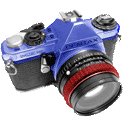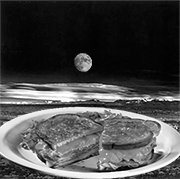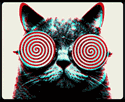|
I THINK I might know the answer to this, but I completely guessing so I might also be full of poo poo. Your scanner is probably a CIS scanner, which runs a row of RGB LEDs across the document flashing the three colours, and the photodiode on the scanner records the amount of light of each colour that is bounced back by the scanned document. The reason why you probably can't scan negatives or anything transparent on a CIS scanner is probably because the negatives don't bounce back light well enough to get a scan. So when you illuminate the negative from the top, you're essentially tricking the scanner into thinking the iPad's light is the light being bounced back. The problem is, the photodiode in a CIS scanner is "dumb" and only records light intensity, not wavelength. Whereas normally a non-transparent document would bounce each of the three colours back with varying intensity, telling the photodiode what colour it really is, the iPad's is "bouncing" all three colours back at the same intensity, limited only by the level of transparency of the negative (in actuality the photodiode is not recording the light from the LED array at all but rather only the iPad). A CCD scanner and a camera's image sensor works, because the sensor arrays in both of those things have colour filters, so when it records the light from the iPad, it is only recording once per pixel instead of the CIS scanner's three, and because of the colour filters it knows the "correct" (inverted) colour it is. I have no idea if any of that makes sense, I'm kind of doped up on T3s. Geektox fucked around with this message at 06:05 on Feb 14, 2014 |
|
|
|

|
| # ? May 13, 2024 22:58 |
|
That is a lot to wrap my head around, but thank you. I guess I'll be scanning with my dSLR for the time being.
|
|
|
|
Geektox posted:I THINK I might know the answer to this, but I completely guessing so I might also be full of poo poo. loving
|
|
|
|
Actually no, I'm no quitter. We've been to the loving moon I KNOW there's a way I can trick this stupid scanner using science. I'll report back when I think of something.
|
|
|
|
LargeHadron posted:Actually no, I'm no quitter. We've been to the loving moon I KNOW there's a way I can trick this stupid scanner using science. I'll report back when I think of something. Maybe you could take three scans, with the iPad set to backlight the film with #FF0000, #00FF00, and #0000FF, respectively, and then composite them?
|
|
|
|
Yond Cassius posted:Maybe you could take three scans, with the iPad set to backlight the film with #FF0000, #00FF00, and #0000FF, respectively, and then composite them? Alternative Process Scanning
|
|
|
|
Yond Cassius posted:Maybe you could take three scans, with the iPad set to backlight the film with #FF0000, #00FF00, and #0000FF, respectively, and then composite them? Yesssssss
|
|
|
|
Yond Cassius posted:Maybe you could take three scans, with the iPad set to backlight the film with #FF0000, #00FF00, and #0000FF, respectively, and then composite them? This is crazy enough to do something interesting probably.
|
|
|
|
Digital gum bichromate, nice.
|
|
|
|
Yond Cassius posted:Maybe you could take three scans, with the iPad set to backlight the film with #FF0000, #00FF00, and #0000FF, respectively, and then composite them? Oh god, do this and report back. Now I'm curious.
|
|
|
|
Yond Cassius posted:Maybe you could take three scans, with the iPad set to backlight the film with #FF0000, #00FF00, and #0000FF, respectively, and then composite them? It just occurred to me I could probably do something like this to act as a colour correction filter (and maybe compensate for the orange cast in colour negatives). Might make dslr scanning colour negatives easier...
|
|
|
|
I had a dream last night that I scanned them by putting a mirror facedown over the negatives. I was stoked when I woke up because it kind of made perfect sense. It didn't work (too dark)  I'll try the RGB backlight stitch a bit later...I'm curious though what the theory is as to why that would work. Wouldn't comping an image from RGB-backlit components have the same effect as using a white backlight, in "light" of what forums user Geektox explained? Then again, I'm the guy who tried scanning a mirror so I'm pretty stupid.
|
|
|
|
LargeHadron posted:I had a dream last night that I scanned them by... This is the point you should go and play outside for a while.
|
|
|
|
Yond Cassius posted:Maybe you could take three scans, with the iPad set to backlight the film with #FF0000, #00FF00, and #0000FF, respectively, and then composite them? ahahhaha
|
|
|
|
LargeHadron posted:I'll try the RGB backlight stitch a bit later...I'm curious though what the theory is as to why that would work. Wouldn't comping an image from RGB-backlit components have the same effect as using a white backlight, in "light" of what forums user Geektox explained? Then again, I'm the guy who tried scanning a mirror so I'm pretty stupid. OK, this is pretty handwavey, but basically: A CCD scanner can read luminescence values for all three colors at one go, separating them out of white light, so its routine looks like this: code:code:Make sense?
|
|
|
|
Well drat. That actually worked. RGB composite:  rgb-compose by LargeHadron, on Flickr White light:  scan0003 by LargeHadron, on Flickr The colors are a little off, but to be fair the app I was using doesn't have options for true RGB...more like red, sea foam green, and sky blue. I have to admit I'm pretty excited, more so about the "cool science" aspect than the actual result.
|
|
|
|
LargeHadron posted:Well drat. That actually worked. Woo! I was trying to figure out how it would work yesterday, but my old as poo poo Canon LiDE 20 is busted. My first thought was also to use a mirror
|
|
|
|
LargeHadron posted:Well drat. That actually worked. Whoo! You don't really need an app. You should be fine if you just make some PNG files to the resolution of the screen and put them in full-screen display mode. Then you can get exactly the color balance you want.
|
|
|
|
Ok I finally got around to scanning one more carefully using the RGB screen method. rgb-compose (2) by LargeHadron, on Flickr The original photo is very underexposed, that's not a scanning problem. I would call this technique a genuine success! Thanks Yond!
|
|
|
|
Don't know if I should plonk this here or the film thread. Absuing some temporary access to a v700 I ran a roll through today and got some lovely adujusted scans out of the Epson Scan software (no Vuescan for me) plus some non-adjusted but inverted versions. Trouble is no matter which guide I follow for levels/curves adjustment to remove the blue tint the outcome is always awful. They're 16bit Tiffs. Original  'Fixed' using levels adjustment either in auto or by setting individual channel black/grey/white points. That's the 'best' I've got it, no matter what I do the cyan highlights remain XTimmy fucked around with this message at 09:15 on Mar 3, 2014 |
|
|
|
You should avoid using auto levels for un-adjusted pictures. It just maximizes the displayed dynamic range, which tangentially also can be bad for printing. What you *should* do is go into each channel and set the start and end points for R, G and B. Leave the midpoint alone! Doing this has yielded me this. My work screen is lovely and overly warm IMO, so YMMV.  Now that you have this image, which is at least somewhat resembling reality; now you can go ahead and adjust the midpoints, play with the curves, and basically do whatever to achieve the tone and look you want. Don't try to go there straight away, it will almost always result in a mess. Even for me, and I've done tons of photos like this. Basically, first the basics, then the screwing around. VomitOnLino fucked around with this message at 09:31 on Mar 3, 2014 |
|
|
|
Thanks! Using a levels or curves control? Because I tried setting the black and white points for each channel in these and the end result is what you see in my post. Hard cyan highlights. I'm wondering if I'm just not playing enough.
|
|
|
|
XTimmy posted:Thanks! Using a levels or curves control? Because I tried setting the black and white points for each channel in these and the end result is what you see in my post. Hard cyan highlights. I'm wondering if I'm just not playing enough. What method do you use? Here's under five minutes of PS:  I used threshold to find the whitest and blackest points in the image, then dropped measuring points on those, then opened the info panel and curves layer, set the endpoints of the RGB curve so that the B&W points are all the same number give or take a couple of points, then a quick manual levels layer to increase contrast and boom done.
|
|
|
|
XTimmy posted:Thanks! Using a levels or curves control? Because I tried setting the black and white points for each channel in these and the end result is what you see in my post. Hard cyan highlights. I'm wondering if I'm just not playing enough. Open curves, select the red channel. Check 'show clipping'. Drag the leftmost point towards the right until you see dots appear, then back off until the dots disappear. Repeat for the rightmost point, bringing it left. Switch to the green channel, repeat, blue channel, repeat. Enjoy.
|
|
|
|
ansel autisms posted:Open curves, select the red channel. Check 'show clipping'. Drag the leftmost point towards the right until you see dots appear, then back off until the dots disappear. Repeat for the rightmost point, bringing it left. Switch to the green channel, repeat, blue channel, repeat. Enjoy. http://youtu.be/u_qeZOWqchM
|
|
|
|
Using threshold was something I hadn't tried. I was using levels or curves and the show clipping function which should have done much the same but eh. I'll give it another shot tonight. Thanks for your help and patience!
|
|
|
|
I use threshold because it's fast and I had no idea that "show clipping" even existed.
|
|
|
|
Thanks again guys, I was more or less doing all that from the get go with no real results. Hope I'm not being too needy here but I uploaded a video of my process so you can all see me fail horribly. Maybe you can tell me what the dear christ I am doing wrong. https://www.youtube.com/watch?v=Q2nq8yh_ah0
|
|
|
|
XTimmy posted:Thanks again guys, I was more or less doing all that from the get go with no real results. You had it right, with none of the color channels clipping. Then you brought the black points way in. Why? You can remove the cyan cast by placing points in the middle of the curve rather than loving with white/black points more. It does look like you could set the blue white point a little higher, too.
|
|
|
|
Learning curve: Doing this in CYMK is mucchhhh easier. Still green but I can handle a bit of green. Edit:VVVVVV Thanks but I'm good, slight casts are easy enough, I know you don't have to handle that in CYMK, I just found getting to a base image from the cyan mess was easier. XTimmy fucked around with this message at 08:49 on Mar 5, 2014 |
|
|
|
Use the eyedropper tool and bring down the green channel where that green cast is. You don't need to do this in CMYK.
|
|
|
|
Hi. I'm not sure if this is a correct place to ask this question but there are hundreds of strips of negatives in my drawer and they've waited for scanning for... oh about 5 years now. I'm wondering if you could recommend a company, which would be able to do that (in RAW - I'd like to make post-processing adjustments myself). I found places like online: http://www.scancafe.com, http://www.dijifi.com. Any suggestions or ideas? Thank you.
|
|
|
|
Unexpected posted:Hi. I'm not sure if this is a correct place to ask this question but there are hundreds of strips of negatives in my drawer and they've waited for scanning for... oh about 5 years now. I'm wondering if you could recommend a company, which would be able to do that (in RAW - I'd like to make post-processing adjustments myself). I found places like online: http://www.scancafe.com, http://www.dijifi.com. We used scancafe at my old job to go back and re-digitize a huge amount of stuff shot originally scanned in the late 90's at like 640x480 (total came to like US$5-7k or something) and my boss was very happy with what he got back. If it was just 35mm and you weren't after 100% top quality for everything, I'd be tempted to build something around a slide/negative duplication rig and an old manual focus macro lens, and crank through it with a DSLR and some tethering software (which is how I did a different 35mm slide digitization job at my old work). I will probably do the same with my parents' drawer full of negatives when I get back to the US for a few months later this year, since I'll be unemployed (ie my time will be worthless) and won't need the quality of a flatbed for the vast majority of it. That, and I kinda hate scanning film. *shootz glare at the V750 Pro on my desk I haven't used in like a year, and box of ~75 rolls of medium format to be scanned...*
|
|
|
|
What are the general best practices for scanner settings? Right now I manually adjust the clipping points on the histogram using the Epson software, set unsharp mask to medium, and leave everything else off. I am wondering if I should disable unsharp mask and just do sharpening in lightroom. Check out what the "dust removal" setting does on the medium setting: No dust removal:  Medium dust removal:  Does an okay job at removing some scratches but notice what it does to the tuner dial lights. This is my 2nd roll I've developed and I wiped it dry using a cloth instead of a squeegee. I did it a bit too early and looks like I scratched the emulsion a bit  Oh well, live and learn. Oh well, live and learn.
|
|
|
|
Dust by hand in PS/LR, scan with minimal settings (no b/w points, no inversion, no sharpening.) No reason to trust your scanning software.
|
|
|
|
By "no b/w points" do you mean you put the histogram points across the whole spectrum, even if there's nothing at either end?
|
|
|
|
I haven't found any increase in DR by setting the points in the scanning software. If you're going to have to edit the curves elsewhere you might as well just scan each negative the same (no points.)
|
|
|
|
IR dust removal stuff doesn't work with black and white film, but I find it usually works pretty well with color. I usually have to go back and hand touch up some places though.
|
|
|
|
Vuescan and Silverfast both clip my whites frequently, so I scan raw... I can't imagine the epson software being any better.
|
|
|
|

|
| # ? May 13, 2024 22:58 |
|
notlodar posted:Vuescan and Silverfast both clip my whites frequently, so I scan raw... I can't imagine the epson software being any better. Silverfast can be persuaded to let you keep the highlights, usually. In the nega-fix tab, there's an "Auto tolerance slider", if I slide that all the way to the left I usually get to keep all my highlights, even with film where I botched the dev due to being lazy.
|
|
|
























